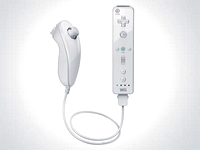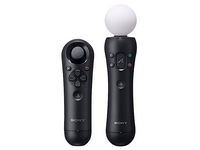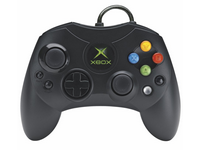
You gotta love the Wii.
It was a three-lettered nonsensical word that revolutionized the video gaming industry. Wii was not the first platform that introduced motion gaming to the masses, but it certainly was the leader in popularizing the idea to a widespread consumer market. Since its product launch in 2006, this video gaming console has sold over 75 million copies worldwide. Fellow competitors were prompted to introduce similar motion sensing systems like the Playstation Move and XBox Kinect. Gone are the button mashing days on your clunky wired controllers. The new era of video gaming introduced a head bobbing, neck twisting, hand wringing, leg kicking, and body shaking human controller.
The Wii implemented an innovative interactivity to the gaming experience, which is its biggest selling point by far. Previous video gaming consoles encouraged the role of the distant spectator, where you enter commands through a controller and observe the happenings on a remote screen. Nowadays, the focus has shifted to your role as an active participant. Since your physical movements correspond with those of the virtual character, you naturally become more involved and more engaged with the gaming experience.
For example, you swing your arm as if you are holding a tennis racquet, hitting a nonexistent ball within an imaginary court. Or you tilt your controller as if you are handling a delicate object, in an effort to master the art of balance and accuracy. This interactivity elevated the gaming experience because it makes you feel like part of the simulation. In other words, we are one step closer to immersing our physical beings into an entirely virtual dimension.
For example, you swing your arm as if you are holding a tennis racquet, hitting a nonexistent ball within an imaginary court. Or you tilt your controller as if you are handling a delicate object, in an effort to master the art of balance and accuracy. This interactivity elevated the gaming experience because it makes you feel like part of the simulation. In other words, we are one step closer to immersing our physical beings into an entirely virtual dimension.
Welcome to the new generation of video gaming.
Analysis
Video games used to be a niche market, targeted towards a younger (and often male-oriented) age bracket. While this is still the predominant consumer group, motion gaming has a much broader appeal across multiple demographics. This is attributed to the Wii's marketability as a family-friendly console, with many competitive and cooperative multi-player video games that are popular among all ages. In particular, the expansive gaming catalogue - from action adventure to sophisticated strategic simulations to lighthearted party games - removed much of the stigma that video games are only associated with youths.
The novelty of motion gaming, especially in an easily accessible household environment, also increased its popularity with the masses. The Wii is no longer just a new toy for children, but it is a unique and innovative consumer product that genuinely captivated the market's interest. The existence of motion gaming is comparable to the initial launch of the television technology, where it revolutionized our standards of recreational entertainment forever.
The novelty of motion gaming, especially in an easily accessible household environment, also increased its popularity with the masses. The Wii is no longer just a new toy for children, but it is a unique and innovative consumer product that genuinely captivated the market's interest. The existence of motion gaming is comparable to the initial launch of the television technology, where it revolutionized our standards of recreational entertainment forever.


The popularity of motion gaming is also attributed to the modern phenomenon with authenticating any virtual reality. For a similar reason why 3-D technology became a recent trend, the idea of simulating real life is very marketable. It used to be that we navigate through video games via buttons and joysticks, but these items take the player out of the gaming experience somewhat. Pressing a button to swing a racquet or deliver a punch does not carry the same thrill as actually emulating the action with our arm.
As such, newer models attempt to instill real-life simulation by minimizing or substituting the use of physical controllers. For example, the XBox Kinect is particularly noteworthy for allowing the players to interact with the video game with just their bodies. Similarly, the Wii's balance board increases the spectrum of the player's control and jurisdiction. Motion gaming has become popular because it subdues the 'virtual' aspects from our virtual reality, thus allowing us to become more engaged and more immersed within the gaming experience.
As such, newer models attempt to instill real-life simulation by minimizing or substituting the use of physical controllers. For example, the XBox Kinect is particularly noteworthy for allowing the players to interact with the video game with just their bodies. Similarly, the Wii's balance board increases the spectrum of the player's control and jurisdiction. Motion gaming has become popular because it subdues the 'virtual' aspects from our virtual reality, thus allowing us to become more engaged and more immersed within the gaming experience.
Like many leisure activities, video games can provide a momentary escape from real life. Once the gaming console is turned on, you adopt a new character persona, adapt to a new virtual environment, and assume a new simulated reality that is different from your current existence. Adolescents often use video games as fuel for their youthful imaginations, whether they wish to save the world from imminent destruction or they hope to reach the top of their expertise fields. Similarly, these games also distract some adults from the stress of their everyday lives, since they are a convenient form of entertainment after a hard say's work. In either scenario, video games have the power to create a brand new identity for the user, so that they can temporarily forget about their real-life troubles.


As video games continue to evolve towards simulating real life, don't be surprised if the next generation of video gaming involves physically interacting with a virtual environment. Augmented reality is a rapidly expanding sector that will soon find its marketability in the video gaming industry. Soon enough, controllers like the Wiimote and the Nunchuck may not be necessary altogether. It is only a matter of time before we can leave behind our physical reality and enter into an entirely virtual world.





No comments:
Post a Comment